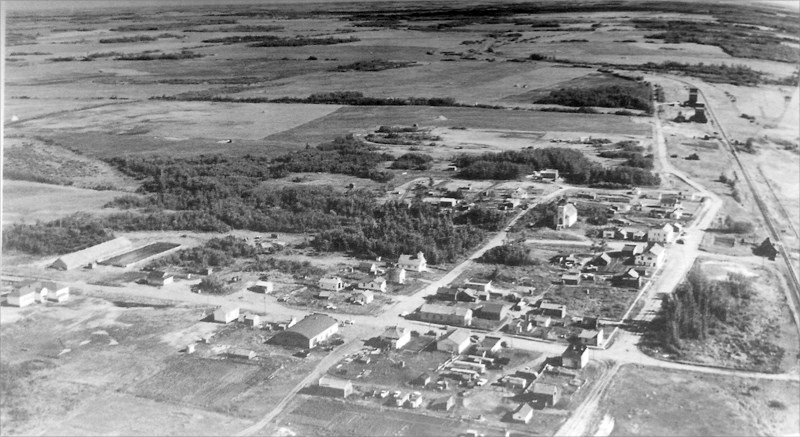There's no arguing that, like many small communities in Alberta, the Hamlet of Busby has lost a lot of the businesses and volunteer organizations that at one time operated in town.
There's no arguing that, like many small communities in Alberta, the Hamlet of Busby has lost a lot of the businesses and volunteer organizations that at one time operated in town.
Claire Stitsen, one of the organizers of the Busby Centennial, said there was once a Co-op, a branch of the Royal Bank, the Imperial Lumber Company and an operating elevator.
Although it's lost many of those things, Busby also has many third and fourth generations of the same family residing in the area and sending their children to Busby School. Some have even moved back to the community after leaving for a time.
'It's lost a lot of businesses, but I still think it's a thriving town," said Stitsen.
Showcasing that history was a big part of the Busby Centennial celebration this past weekend. Visitors to the community were able to not only go on historical tours, but also to pick up history books with special stories submitted by local families.
Busby's origins actually go back a little earlier than 1915. Settlers had arrived in the area at the beginning of the century, and in 1903, the first store and post office opened just southwest of where Busby stands now by a man named John Shoveller. At the time, the place was called simply 'Independence."
However, as with many rural communities, Busby's existence became intertwined with the railroad. The Edmonton Dunvegan and B.C. Railway was incorporated in 1907 and in 1912 track was laid through what is now Busby.
It was standard for a town site to be surveyed every few miles along the railway, and Busby was established at one of those sites. Shoveller's post office and store eventually moved over to the site, and the community was re-named Busby in 1915.
How Busby exactly got its name is a matter of some debate. One story is that it was named for a civil engineer who worked on the railway; another popular take is that the name was chosen to mirror a English or Scottish community of the same name, as with many communities in Alberta.
Following the founding of the community, the Busby Agricultural Society was formed in 1917 and later purchased the land that would become the Busby fairgrounds in 1920.
In 1918, construction began on a Busby Community Hall, which was completed in 1920.
By 1927, the community boasted two stores, a post office, two blacksmith shops, a butcher shop, a garage and a train station, all serving about 50 residents. An elevator was built the next year by the United Grain Grower (UGG) - at the same time a railway branch line was installed running from Barrhead to Busby.
Busby School opened as an elementary school in 1928 and by 1931 had 37 students.
A high school briefly operated out of the Busby United Church, but it was closed down in 1940.
By 1945, Busby had two stores and churches, a station agent, blacksmith shop, hotel, post office, pool room and caf é.
Busby got a telephone switchboard in 1946 and pole lines were installed in 1947, while electricity came to community about six years later, in 1953.
New churches sprang up in 1963 and the United Grain Growers took over the Searle elevator in 1965, only to close it in 1972.
As with many communities, there were also disasters in Busby's history, such as the burning down of the school in 1946 and the destruction of a garage six years later, resulting in the owner opening a new electrical and hardware shop.
The community's new hall that was built in 1962 burned down only five years later.
The late 1960s-early 1970s also marked a point where many local businesses were shutting down.
The Busby Railroad Station - the reason for the community's existence - closed in 1966. The Busby Co-op survived long enough to celebrate its 25th anniversary in 1970, but closed down only three years later. Both local elevators were also demolished in 1974.
But some institutions also survive to current day.
The Double Diamond 4-H Club, which ran an agricultural fair at this year's centennial celebration, was formed in 1970.
The Busby Lions Club - formed in 1980 - was one of the organizations that assisted in organizing the centennial celebration.
The Busy Bee Mart moved to its current location in 1993, and it was taken over by Cathy and Conrad Sehn in 2000.
The late 2000s brought a major new event to the area.
In 2009, Busby area resident Trudy Taphorn organized a small concert with Elvis tribute artists for friends and family.
The event has grown considerably; in 2012, the festival moved to the Busby fairgrounds due to the sheer number of people attending.
Last year, the Blue Suede Music Festival drew more than 3,500 Elvis fans, and the event shows no sign of slowing down.
In 2013, St. Anthony Catholic Church was demolished 81 years after it was built in 1931. However, the Westlock Regional Water System also extended water lines out to Busby.
Many of the lost landmarks in Busby were recognized this weekend with stakes and signs detailing information about them, along with models created by a local artist.
